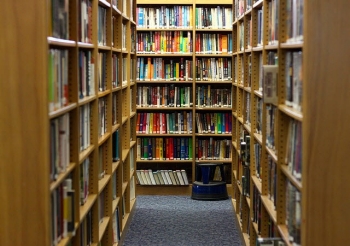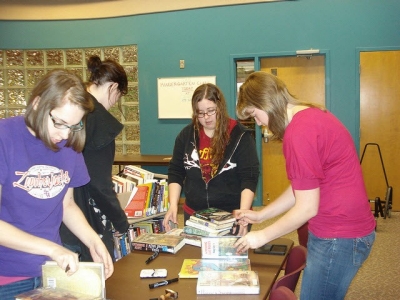Seven Answers to Seven Weeding Questions

Originally published July 21, 2017
Deciding how to weed your library's collection can be daunting. Decisions about criteria and policies are important to address to provide guidance and clarity to staff. Holly Hibner, Adult Services Coordinator, and Mary Kelly, Adult Services Librarian from the Plymouth (MI) District Library are helping us explore this topic by answering seven weeding questions posed by participants in the Small Libraries Create Smart Spaces project.
1. "We are constantly weeding but are not able to remove enough based on our current weeding criteria. How do we make more room?"
It might be time to reconsider your weeding criteria. Specifically:
- Do you have written collection objectives?
- Do you have benchmarks for each collection for circulation, age, etc.?
- Are you clear on the library's mission and how the collection helps the library meet that mission? For example, are you a popular materials library, or do you serve an academic community (not just university, but community college, advanced placement high school classes, private schools with specific curricula, high school baccalaureate programs, for example.)
- Are you being brutal? Reeeeaaally brutal. It's ok to keep one or two favorite items that you just can't bear to part with, but are you holding on to too many things for sentimental reasons?
- Is a staff member sabotaging your efforts? Is everyone on the same page, following the same objectives and benchmarks, and clear on the library's collection philosophy?
- What is your collection philosophy? Are you trying to create a broad collection or a deep collection? Do you want to have many items on a few subjects or a few items on a wide variety of subjects?
- How important is "serendipity" to your collection philosophy? Do you purchase items that look cool (and are genuinely cool) in the hopes that patrons will stumble upon them and check them out, even though they didn't come to the library specifically to find them? Along the same lines, do you buy another copy of a popular bestseller or one copy of a debut author or one-off item that just seems kind of neat?
Assuming you can't re-do layout or reorganize, try going collection by collection and see if it is something you can live without. For example, maybe you could dramatically downsize music CDs or older formats of audio books and then actively market options like downloadable materials.
Here's a formula to consider:
- A collection making up X% of the total volumes should make up roughly the same % of total circulation. For example: If the 500s account for 15% of the total non-fiction collection in terms of number of volumes, then the 500s should make up close to 15% of total non-fiction circulation.
- If collection size is greater than its % of total circulation, weeding is needed.
- If collection size is less than its % of total circulation, add more titles or allocate more budget to that collection.
The goal is to balance collection size with % of total circulation. This works best if you only include like items in the calculation (do a separate calculation for each Dewey category, for example, comparing it to total non-fiction.)
2. " Space taken up by downsized collections is quickly reallocated to collections with higher demand like large print and other media like console games. How do I reorganize the space?"
You may want to consider "shelf balancing." Here are some blog posts we wrote about this idea:
http://awfullibrarybooks.net/shelf-balancing-part-1/
http://awfullibrarybooks.net/shelf-balancing-part-2/
http://awfullibrarybooks.net/shelf-balancing-part-3/
http://awfullibrarybooks.net/shelf-balancing-part-4/
How to estimate shelf capacity: http://awfullibrarybooks.net/size-matters-estimating-shelf-capacity/
3. "What do I do about those fiction series books with several titles?"
Fiction is usually the most difficult to weed, so this is a tricky one, and very dependent on the needs of each library's specific users and its physical layout. Some suggestions:
- Keep the first 3 or 4 titles in the series to get readers hooked, then let them ILL the rest of the titles in the series.
- If the cost of ILL is too high, consider putting the first 3 or 4 titles on the shelf and putting the rest of the series in storage.
- If the series is still being written, you can put the first 3 out and the most current 3. Storage or ILL for the rest.
- No storage space? Goodness knows the small libraries we have worked in had no storage space! This is where you'll just have to make some hard choices:
- Weed completed series that haven't been added to for X years (you decide the benchmark.) No new title in five years? Ten years? You're out!
- You can also keep the LAST few titles in a series and weed the front end. This satisfies those still keeping up with a series and limits new readers, so eventually you can get rid of the whole thing. The down side of this strategy is readers’ advisory. You can't necessarily recommend your favorite old series anymore to new patrons.
- Ebooks are soooo expensive. Can you purchase a cheap Kindle and buy $3 copies of series through Amazon, rather than relying on Overdrive or another library ebook platform? I don't know the legalities of circulating these things, but it would be a much cheaper way to provide electronic copies of books in series.
- Again, be brutal with your weeding criteria and benchmarks. Get rid of extra copies of older items.
Mary: I actually dismantled an entire stack of Anne McCaffrey. I kept the first books in the series and the most recent only. (Include a shelf or bookmark that talks about options for ILL and downloadable materials.) No one really said anything as the circulation was low on many of the titles. I did this with other big authors as well (Evanovich, Patterson, Nora Roberts, etc.)
What I ran into with my former library staff is they were torn between making sure we had the "classics" or award winners but even when they didn't circulate, they couldn't part with the books as they didn't think we could be a "good" library without them.
4. "...what about interfiling our fiction collection. Is this something we should try?"
Holly: I love this idea for certain building layouts. It really might buy you some shelving in different parts of the library. You can keep stickering or labeling them as mystery, sci-fi, etc. for browsing purposes even if they are interfiled.
Mary: I am ALL OVER THIS IDEA!!! I actually did this and we freed up a lot of space when everything was just fiction. If you combine this with weeding and moving the collection around, you might minimize the scrutiny of too much weeding. Reorganizing the shelving is less controversial than weeding (in general). I also think this should apply particularly to teen and youth fiction. Kids age out of stuff so fast, if circ drops dramatically after a couple of years, it probably should go.
5. Should we reconsider the necessity of our reference collections and non-fiction?

Courtesy Rapid City Public Library
Is it really necessary to have a reference collection at all? Could you free up space by removing reference collections altogether?
- What are you labeling as reference use only? Could some of those items circulate? Could you pick your top 10 reference titles and keep them at the reference desk at "Ready Reference" items and weed everything else?
- Do you have multi-volume sets that haven't been cracked open in years?
- What reference books are you holding onto that are now available through databases? There are LOTS of reference materials available in general databases!!
- What reference books are you holding onto that have information just as easily found, searched, used, etc. on the free web?
Nonfiction for both youth and adults should be weeded to the extent you can get better or more current from the databases and the web. I still run into kids that need an actual book, but dig into what topics are still being taught. For nearly 10 years 4th graders in our town were doing insect reports (yes, kids brought us bugs to identify.). We doubled up and bought extra and then they switched to trees and again we needed to do the same. Interfiling nonfiction DVDs with the books might make more sense with respect to space.
6. One more idea: Can you revise circulation policies?
You don't have to make space for items that are checked out, so check more stuff out for longer.
- Are you restricting patrons to a certain number of items at a time? Why? You could get MORE items off the shelves and in use if you don't limit people. Take all the DVDs, CDs, magazines, and books you want!
- Are you having to find shelf space for items because they don't circulate long enough? Circulate movies for a week rather than a few days. Circulate magazines for the same amount of time as books. Basically, look closely at how long every item type circulates for in your library and extend that a bit.
7. How do I focus on spaces I should have vs. spaces I’ve traditionally had?
Do a space study. Go around the library once every hour for a few days or a week and observe people.
- How many people are in each area?
- Who are those people? (For example, are there adults in the youth section? Teens in the youth section? Adults in the teen section? Seniors in the local history room?)
- What are those people doing? Are they reading casually, browsing the shelves, sitting on the floor, spread out at tables, using computers, talking on their pho ne, tutoring, knitting...literally, what are they doing?
- What times of day/days of the week are certain things being used the most/least?
- Keep track of what people asked for. Study rooms? Places to plug in their devices? Places to take phone calls?
- What do you constantly have to say "no" to? No, we don't have charging stations. No, the study rooms are full. No, you can't use your phone here. What would you need to do to say yes?
- What items never seem to be asked about or used? As you count people, also pay attention to what they are NOT doing. Are they not using a specific online catalog terminal? Are they not sitting in a specific chair? Is the lighting bad there? Is there a draft from a vent? Is it too close to the reference desk and the staff are too loud?
- Also keep track of outside factors, like an increased use of bathrooms/chairs/tables/computers/whatever on community festival days, rainy days, free-coffee-for-seniors-at-the-cafe-next-door days...
- Keep track of items that are out of order, like copy machines, computers, fax machines, wifi, etc. How did that affect the use of other services? Did people sit around waiting for it to be fixed? Did they use books instead of computers because the computers were down?
Thanks to Mary and Holly for lending their expertise!
Toolkit for Creating Smart Spaces
WebJunction offers a toolkit to help you re-envision your library’s place as a center of community learning. Explore more of the Toolkit for Creating Smart Spaces.
